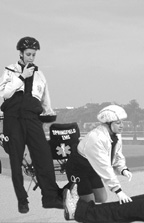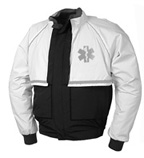|
by Grant Rosenberg
According to Maureen Becker, executive director of the International Police Mountain Bike Association in Baltimore, Md., the uniform industry is fulfilling a need in this area. “Ten years ago, when we were just getting started, there wasn’t much of anything appropriate for police officers to wear [on bikes],” she explains. “They’d end up cutting off regular uniform shirts or pants and basically biking in a version of their regular uniforms. Since that time, though, uniform manufacturers have responded to the individual needs of first the police and now, bike medics. As the EMS cyclist movement has gained popularity, more manufacturers are beginning to make uniform components that are appropriate for EMS personnel.” Before the introduction of bike-specific clothing, the uniforms worn by police cyclists were in many instances heavy polyester or 100 percent cotton, both of which are uncomfortable to ride in. Becker continues, “These were standard issue uniforms that were not designed for the comfort of anyone sitting on a bike seat for multiple hours. Now there is the ability to make very professional-looking attire that is also comfortable for exertion.” Already specializing in police bike patrol uniforms, Pro-Tuff Uniforms recognized this proliferation and has expanded their line to accommodate the growing need for bike medic uniforms around the country. “It was just a natural extension of our business,” says Pro-Tuff’s Marketing Director, K.C. Werner. “We’d been asked by end-users, and we’d been keeping our eyes open. We’d attend the conferences. For example, at the International Police Mountain Bike Association Conference in Cincinnati last May, many of the attendees were bike medics.” Pro-Tuff Uniforms has earned a reputation as The Pocket People, for their pants that feature a plethora of pockets and the Pro-Tuff glove pocket specifically. It holds up to six pairs of gloves while providing quick access to a knife, flashlight and a pair of scissors. The company already offers the Comfort-Tek Glove Pocket Pant, with its elastic waist, six Velcro closure belt keepers and, in addition to other pockets, two front quarter pockets and two zipper closure hip pockets, and the original Pro-Tuff Glove Pocket on the right thigh. The bike medic uniform builds upon these features, though not without its differences, according to Werner. “The glove pocket pant is a poly/cotton twill. It’s a very heavy fabric, designed for crawling around on the ground.” This is in direct contrast to the bike pant that is designed for the flexibility of bike-pedaling. “The bike medic pant is made from Supplex Nylon and is much lighter and breathable.” Also, it features elastic ankle cuffs to keep the pants from getting snagged on the bicycle chain as well as outseam zippers that enable the pants to easily slip over shoes. In addition to the pants, there is also a Bike Medic Glove Pocket Short, designed both for EMS and marine patrols. It has six pockets and is unlined for comfort and easy maintenance. All are available in navy, black, brown, olive and dark spruce green. Presently, Pro-Tuff’s bike medic uniform is being wear-tested by over a dozen different agencies across the country. “EMS agencies were using our law enforcement bike uniforms,” says Werner, “and they said, ‘well this doesn’t really work that great for our needs. Can you put more functional EMS pockets on this stuff?’ And we said sure.” In other words, the design of the uniforms is an ongoing process, dictated by the specific occupation. “We listen to our customers constantly,” continues Werner. “At trade shows, we go out and work with them, do ride-alongs. We watch what they do, and try to get to the root of the uniform’s drawbacks.” When asked for an example, Werner relates how that the original glove pocket pants’ design arose from the many comments by wearers that they needed a place to put gloves, and wanted a watch pocket, too. “We said, ‘No, we don’t want to do that,’ ” Werner recalls, “because you do your job on your knees, and you aren’t able to access a watch pocket up near the waistband. So we moved the glove pocket to the side of the thigh. That way, if medics are down on their hands and knees working on a patient, they can reach their gloves. The products just evolve rather than coming fully developed in finished form.” Due to issues of climate, there is a greater prevalence of bike medics in the more temperate states of the South and Southwest, but also northern regions during the summer. “You won’t see them as much in big cities and municipalities,” explains Werner. “But you will at regional and special events where there are large crowds of people, concentrated in an area for short periods of times: summer festivals, concerts and waterfront parks, to mention a few.” Werner mentions that the bicycle allows EMS providers to get to their patients quickly with a lot more equipment than they could carry in packs, because much of that weight is transferred to the bicycle: equipment such as defibrillators, airway tools and medicine. If someone has breathing difficulties, bike-riding medics can get there quickly to treat and stabilize the patient while waiting for an ambulance to work its way through the crowd. “There are many studies being done by the American Heart Association and Red Cross which find that the sooner people get advanced care, beyond just CPR, the better their chance of survival,” continues Werner. “The needs of the public require getting the EMS people closer to the events with lightweight equipment that can move quickly through large crowds. The need for these uniforms is driven by the job that they are doing.” Becker says that the boom in bike medics began in 1997, due to the number of EMS agencies observing the success that police departments were having with bike patrols in terms of service to the community, and they followed suit. She states that there are now more than 250 EMS bike teams nationwide. These days, it’s hard not to notice the ubiquity of cargo pants and similar styles of bottoms that are available to the general public, not only in specialty locations like Army surplus and sports stores, but also in department stores. Werner believes that uniforms follow long-term fashion trends, smoothing out the curves and spikes. “Some short-term fashion trends make it into the uniform sector and some don’t,” he observes. “Jeans, for example, come and go; there are always a certain percentage of sheriff’s departments that use a jeans-cut trouser. But the uniform business is very conservative, and it has to be. Because the images you are trying to projectconfidence, consistency and efficient professionalismare precisely what the uniform should signify. So it is inappropriate to be avant-garde with your uniforms.
Becker agrees that form follows function. “It has made a huge difference for people doing this kind of work, how responsive the industry has been and how far it has come along in such a relatively short time. The manufacturers understand that comfort and functionality are key.” |
| Above story first appeared in MADE TO MEASURE Magazine, Fall & Winter 2001 issue. All rights reserved. Photos appear by special permission. |
| Halper Publishing Company 633 Skokie Blvd, #490 Northbrook, IL 60062 (847) 780-2900 Fax (224) 406-8850 [email protected] |





 “We’ve introduced pleated pants to the EMS market. I’m trying to talk the powers that be into introducing them into the law enforcement market. It makes sense to me. They are more comfortable especially as people age and their waistlines drop.”
“We’ve introduced pleated pants to the EMS market. I’m trying to talk the powers that be into introducing them into the law enforcement market. It makes sense to me. They are more comfortable especially as people age and their waistlines drop.”





